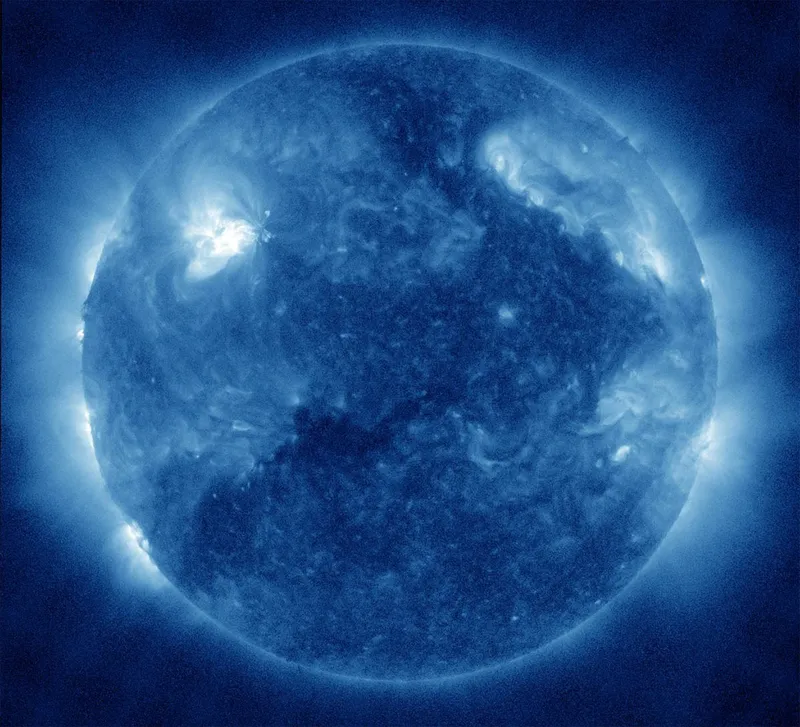Ask a child to draw the Sun and they’re sure to reach for the yellow crayon, but what colour is the Sun?
The answer depends on a lot of things, like whether you’re in space or down here on Earth, whether you’re looking at the midday Sun or a sunset, or if you’re Elon Musk.
Why? Let’s find out.

The white-hot Sun
The colour of our host star is determined by how hot the Sun is.
The surface temperature of the Sun – about 5,800ºC – means it emits energy at wavelengths between infrared and ultraviolet, including those in the visible light spectrum that the human eye can perceive.
When light contains all the wavelengths of the visible spectrum, it appears to us as white.
We know this because refracted white light, like the light behind a rainbow or shone through a prism, is split into its spectrum of colour.
So, because it emits wavelengths of all colours, the colour of the Sun itself is white. At least in space, that is, where light from the Sun can be seen without interference.

On Earth, however, there are particles in the atmosphere that interact with photons of light before they can reach our eyes.
This interference is called Rayleigh scattering and it’s why the sky on Earth is blue: molecules of nitrogen in oxygen in the atmosphere scatter light that is shorter in wavelength, toward the blue end of the visible light spectrum.
This scattering is perceived by our eyes as a beautiful blue (on a good day, that is!).
Rayleigh scattering also impacts the colour of the Sun.
If you were to look at the star while it was high in the sky – though you should never look at the Sun without proper eye protection – you’d see it as mostly white-yellow, because the light has less of Earth's atmosphere to pass through before it reaches you.
As the Sun sets, however, its light has to travel further and will interact with more molecules in its path.
Blue light will be scattered and bounced away from the horizon, whereas the longer wavelength red and orange light will filter through and into our eyes.
This is why a sunset appears a beautiful, deep red on the horizon.

Is the Sun green?
Elon Musk tweeted in 2022 that “what colour is the Sun?” is actually a ‘trick question’, that the Sun ‘appears white in space, but, as measured by peak photon count, it is green’. Is he right?
Musk is referring to the ‘black body spectrum’ of radiation emitted by a body.
It uses the surface temperature of a body, in this case the Sun, to plot on a graph the amounts of different wavelengths emitted.
The black body spectrum of the Sun shows a bell curve, with its peak around 500nm, the wavelength corresponding to blue-green light.
Some telescopes pick up specific wavelengths emitted by the Sun that can’t be seen by the human eye.
These produce images that are coloured, to show that they are different to viewing the star in visible light.

The above image shows the Sun captured in white light and different wavelengths of ultraviolet light, taken by NASA’s Atmosphere Imaging Assembly.
NASA's Nuclear Spectroscopic Telescope Array (NuSTAR) and X-ray Telescope (XRT), meanwhile, capture x-ray data from the Sun.
But just because the star, on paper, emits more blue-green light than that of other wavelengths, can we say the colour of the Sun is green?

The colour of the Sun depends, then, on what you mean by ‘colour’. If you’re asking about the most abundant wavelength emitted, then you could say the Sun is green.
But you’d also have to stop calling things pink, given that pink isn’t on the visible light spectrum, and instead class them as the wavelength it emits most, which could either be red or purple.
If you want to know what colour the Sun is as seen from space, without any interference from our atmosphere, your answer would be white.
Or, if you argue that ‘colour’ is just a description of how our brains interpret the different wavelengths once they reach our eyes, you could say the Sun is sometimes white, sometimes yellow and sometimes red.
